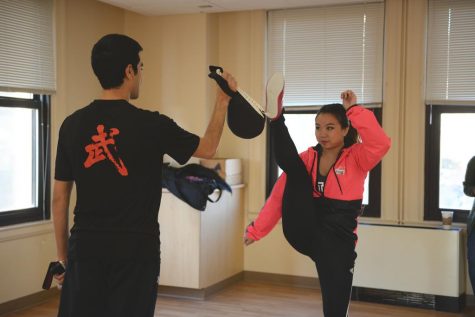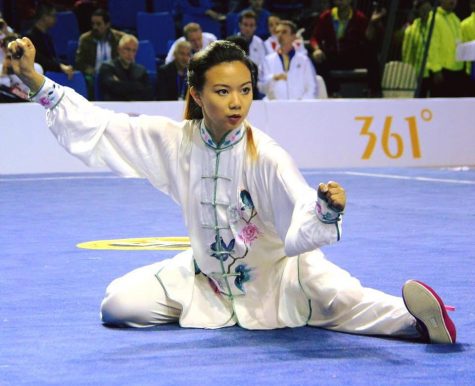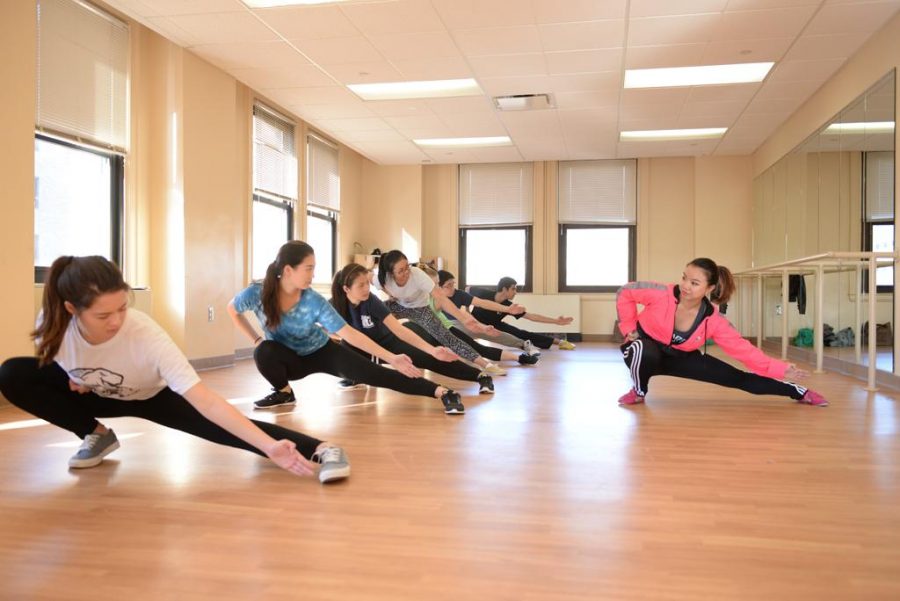Before she had ever attended class, had midnight fries at market or swiped her panther card, Gina Bao had already written the constitution for her wushu club at Pitt.
Bao, a first-year student studying neuroscience, started the club in December 2015 to teach students about wushu, a modern version of kung fu that involves combat martial arts moves with jumps and aerials. The club held its second practice Jan. 9, when eight members from all experience levels showed up to learn wushu techniques in the William Pitt Union Dance Studio. Beginning with simple lessons in bowing and stretching and progressing to complex combinations of running and kicking, Bao hopes to train the members to compete in a national collegiate wushu tournament in just four months.
“At first I didn’t know if anyone wanted to do this with me,” Bao said. “ But then people actually started joining who were actually interested in what was happening, so it kind of became something a little bigger than I thought.”

Bao grew up in Pittsburgh, where her father devoted his life to preserving the authenticity of Chinese martial arts. Bao’s father, Hesheng Bao, is the director of Win-Win Kung Fu Studio in Squirrel Hill, where he teaches classes focused on flexibility, speed, power and spirit.
“Wushu is a contemporary Chinese martial art, and after years, wushu is not only combating, it is also preserv[ing] a lot of Chinese culture,” Hesheng said. “It’s been practiced for a long time in China, but now it’s getting out to the other countries.”
Wushu, which encompasses all Chinese martial arts, is more than 2,000 years old, though it has become more popular recently in a contemporary, competitive form.
Bao began her wushu career in seventh grade when her dad opened Win-Win Kung Fu, and Bao traded in her pointe slippers for swords and traditional silk robes.
“I actually did ballet pretty seriously before then,” Bao said. “But then my dad started a kung fu studio, a wushu studio, in Squirrel Hill and … I realized I had a lot of potential, not to toot my horn.”
Since then, Bao has traveled to Chicago, San Jose, California, Las Vegas and Washington, D.C., to compete in tournaments and has participated in three world championships in China. In 2012, she won two gold medals in her beginner events at the world championship. In 2014, she returned to the world championship in China and took home two silver medals.

When competing in China, Bao heard about big collegiate clubs and tournaments at other universities, such as the University of Maryland. She was immediately inspired to start a wushu group at Pitt.
“But it wasn’t about putting it on my resumé or anything,” Bao said. “I just wanted to be the one who catalyzed the start of something great.”
In April, Bao will bring any interested members — regardless of their previous experience — to perform wushu in their first collegiate tournament at Columbia University. Though she said they are not yet ready to compete, Bao has faith that her team will be ready come tournament time.
“Not everyone who joins has to compete, like you can just come to exercise if you want, but also I want to offer that opportunity to people if they want to have it,” Bao said.
Currently, the Collegiate Wushu Tournament recognizes 24 collegiate wushu clubs—including those at Harvard, Columbia and Stanford— but registration does not begin until Jan. 15. Collegiate Wushu, which started in 1997 at the University of Oregon, aims to bring together wushu teams from all over the country.
Any member registered with the International Wushu Federation is eligible to compete in the championships.
According to Bao, the Pitt club will cover registration costs with funding from the Allocations Committee.
To prepare, Bao said she is still teaching Pitt’s wushu students fundamentals of the sport before moving on to elaborate combinations.
Bao starts each practice by lining all the students up in front of the dance studio mirror and bowing, signaling the start of practice. Following a warm-up and group stretch, Bao leads the members in basic kicks and jumps. The class uses the whole dance studio to practice their forms.
“There’s a lot of things that go into the basics that translate into something more complex whenever you put them together into fluid movements,” Bao said.
Wushu consists of two main forms: taulu and sanda. Taulu emphasizes form and moves and looks like a routine, but does not involve combat. Sanda is combat based and consists of sparring between two opponents, according to Hesheng. Bao mainly teaches taulu, but the class practices sanda occasionally.
For the second practice of the year, Bao invited Ajit Amesur, who she met at the world championships, to lead the class through sparring. Amesur, a medical student from Ohio, has been practicing martial arts, beginning with taekwondo, since he was 12 years old. At the practice, he held sparring mitts for students to hit while he instructed them on their kicks and punches.
Kimberly Wong, an undeclared first-year student, joined Bao’s club despite only having minimal experience with karate as a kid. After two practices with Bao, Wong said karate was far easier than wushu.
“It’s more intense [than karate],” Wong said “It’s more fast paced, and I just think the exercise is more intense in general because it’s only one hour so there’s a lot of stuff to do.”


